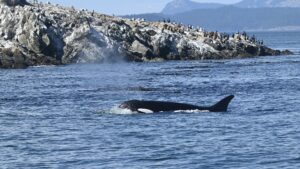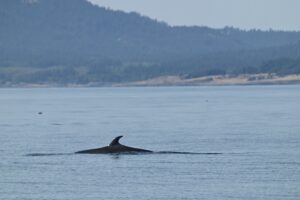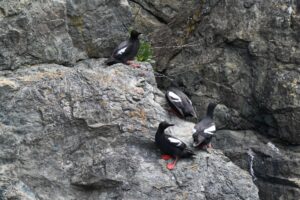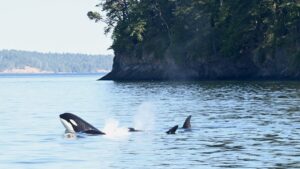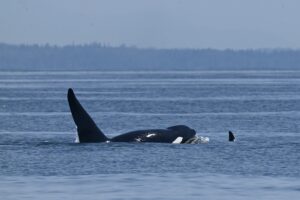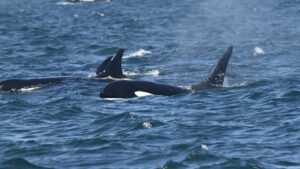This past week was a much different whale watching week, as we had some very windy, wavy, and sometimes foggy conditions on the water. The fog is something to expect when temperatures are often warmer during the day and then cool off by 15+ degrees overnight. We also experienced some pattern shifts in how whales were moving through the central Salish Sea, often having to make much longer trips up into the Gulf Islands of British Columbia to get some “whale visiting” in.
Bigg’s killer whale presence was noticeably down this week. Those family groups that were within our range for trips were: the T36As with the T36A1s, the T65Bs, and then T37A1 was seen traveling with the T46 siblings on two of our encounters, making 15 individuals in total for our tours. It was great to see the T46s for my first time this summer, and nice to know that the quartet is keeping their little family intact after losing their mother and matriarch a couple seasons ago. For more on this well known and storied family group, check out our blog post, here.
A notable for this past week: I can say that the T65Bs came in HUNGRY. On several encounters with these whales the foursome was breaking up into duos and absolutely thinning out the harbor seals at different locations around the San Juan Islands including in Cayou Channel, Cattle Pass at Goose Island, along the backside of Spieden Island, and around the Cactus Islands. Watching this family hunt is often astonishing when they push into very shallow areas. They circle rocks very closely; they often work together to pin seals along island walls or in crevices as they wait them out. They’ll carve their way through kelp beds–it seems as if nothing is “off limits” when the hunt is on. It’s a wonder that this family appears quite “chunky” 😉 and well-fed. No doubt due to a very capable matriarch (T65B Chunk, if you didn’t get my joke), and the skills she has instilled in her three sons.
We also encountered some humpback whales this week, especially off the eastern side of Mayne Island and Galiano Island up in BC waters. Because of the richness of the Fraser River delta, this can be a pretty active feeding area for humpbacks in the summertime. Those humpbacks that we were able to identify through the under-the-tail fluke markings included CRC-13657 “Yogi,” and CRC-15994 “Stitch.” Both of these humpbacks have been matched to the Hawaiian breeding grounds and are presumed (though not verified) males, as they have never been seen with a calf and are both at least in their twenties, given the years they were first recorded (2002 for Yogi and 2001 for Stitch).
When the weather was favorable, we also made our way to Salmon Bank (off the SE side of San Juan Island), where we spotted two of the three minke whales that continue to forage right along the southern shelf of the bank. There were gulls and seabirds-a-plenty out at this site, also, with large groupings of rhinoceros auklets, common murres, and some pelagic cormorants taking advantage of the forage fish density. Heermann’s gulls continue to increase, and with the windy conditions, a few rare-to-our area birds popped up: shearwaters (likely Manx) in Rosario Strait, some Red-necked phalaropes (little on the early side for them), and a juvenile Brown Pelican.
It is DEFINITELY harbor seal pupping season in our area, as well. We saw lots of mom/pup pairs this week, and even happened upon a female seal who appeared to be “seal-sitting” a few very young pups while others were swimming nearby. Harbor seal females will often park their pup some place they deem safe so they can forage–this way they’re able to keep themselves fed and keep up with the milk supply their pup needs! Check out the photo just below for pup-cuteness 🙂
While there is a lot of biodiversity and something new to see each time we get out on the water, the worst part is coming back to the docks without seeing a whale, and we heavily sympathize with guests when this happens. It is important to note that weather and safety come first on each of our trips, especially while riding in our open-air zodiac. It’s also important to note that whales are constantly moving. Killer whales, especially, are moving 60-100 miles in a single day. If that mileage is not made by circling some of the islands, they could be in “our zone” one day, and outside of it the next–sometimes they’re in the zone for one trip and outside of it the next, that’s how quickly things can change. And though our goal is to get as many guests as we can to experience these creatures in their natural habitats, there’s no exact formula to follow to ensure that we see them 100% of the time. None of these whales are tagged, so we rely on day-to-day sightings and some flaw-full “whale mathing” with each sunrise. Sightings were much leaner this last week than any of us expected, or would have liked, and though a bit of an anomaly for this time of year, that’s how it goes, sometimes. For those that did not get to experience the whales, please don’t let this deter you from seeking another trip out on the water to try again! They really are magnificent to behold.
As always, we look forward to seeing what this next week will bring us–hoping for calm winds and seas and uptick of whales!
